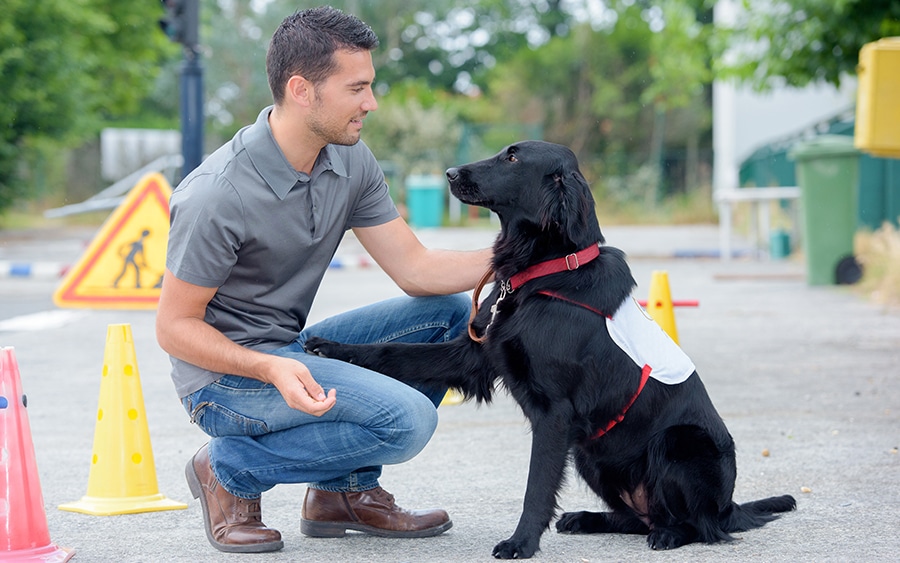TevraPet
Service Dogs 101: Part 3, Advanced Training
Hello again, Tevra fans! This post is part three of our four-part overview of the service dog training process. In our last installment, we talked about raising a service dog puppy. This time, we’ll find out what happens to our puppy during the advanced training. Our next post will focus on the humans who choose to enhance their lives by partnering with a service dog.
LEAVING THE PUPPY RAISER HOME
Most service dog puppies leave their puppy raising home between 14 and 16 months of age. They have at this point learned good house manners and basic obedience. They have also been exposed to stores, restaurants, movie theaters, and anywhere else they may go with their human partners as fully trained service dogs. After spending a year with their puppy raisers, they are ready to move on to formal task training. Formal training takes anywhere from 3-6 months, depending on the type of service dog program
Usually, each new group of dogs spend the first week adjusting to life in the kennels. They go on walks with training staff and enjoy group play sessions. The kennel staff also provide dogs with food puzzles and other forms of enrichment that helps the dogs settle into kennel life.
VETERINARY SCREENING
New dogs also meet the school’s veterinary staff and undergo health screenings during the first week of training. In addition to a basic exam, vet staff screens each dog for hip and elbow dysplasia, cardiac problems, and various eye diseases. Dogs who have a physical issue that prevents them from working get released from the training program at this point. Dogs who don’t complete service dog training are generally called “Career Changes.” A career change can happen to dogs at any point during advanced training. Only the very best dogs become full-fledged assistance dogs. Most of the time, dogs get released from training for things that are a problem for a service dog but wouldn’t be an issue for a pet. In some instances, a dog may not be ideal for service work but would be a great fit for another career. Some career changed service dog trainees go on to make excellent police dogs or do search and rescue. Most career change dogs get adopted by their puppy raisers or get placed in carefully screened pet homes.
GUIDE WORK FUNDAMENTALS
The dogs who pass their health screenings get assigned to an instructor. Each instructor works with anywhere from 4-8 dogs at a time. Trainers spend a lot of time getting to know each dog in their string. They evaluate each dog’s basic obedience and introduce each dog to a clicker. The dogs also get introduced to a harness or other specialized equipment.
Guide dog trainees start learning to pull into the harness and how to travel in a straight line. They then get introduced to 90-degree left and right turns. After that, they learn to stop at stairs, curbs, and any other change in elevation. Then it’s on to guiding the trainer around a variety of obstacles.
They begin learning a concept called intelligent disobedience. Intelligent disobedience involves disobeying their handler if they think their handler could get hurt. The most obvious example is a guide dog refusing to cross the street if a driver decides to cut off the team. About halfway through training, each dog must pass a series of tests to make sure they are progressing well. The trainer works the dog while blindfolded to evaluate each dog’s understanding of the basics. Each dog must demonstrate an understanding of guide work fundamentals before they can learn more advanced concepts.
During the second half of training, dogs learn how to respond to traffic, ride escalators safely, and ride various forms of public transit. They also practice guide work in large cities like San Francisco or New York City. They also spend time on advanced obedience concepts like off-leash recalls and long downs.
PASSING THE EXAM
Finally, each dog must pass a series of final exams before progressing to team training. The instructors again work each dog under blindfold to test their traffic responses, building work, obedience, and ability to complete a complex route. Once the dogs pass all their final testing, they are ready to get matched with their new partners!
We’ll go over how that process works in the final part of this series! We could only give a general overview of harness training because of space limitations, so feel free to ask us questions in the comments!
